The Dell XPS 13 (9300) Review: Return of the King
by Brett Howse on July 16, 2020 10:00 AM ESTWireless
Dell offers two wireless radio options for the XPS 13, and both are Killer-branded. The default wireless card is the Killer Wi-Fi 6 AX1650, which is a 2x2:2 wireless solution based on the excellent Intel AX200. If somehow you missed it, Intel recently acquired Rivet Networks, so the Killer brand should continue to provide the performance and stability of the Intel adapters for the foreseeable future. Dell also lists a second Killer AX500 Wi-Fi 6 option, but this Killer product is based on the Qualcomm 6390 Wi-Fi 6 chipset. Since Killer has been acquired, that part may not be around for much longer. Our review unit features the Intel-based AX1650.
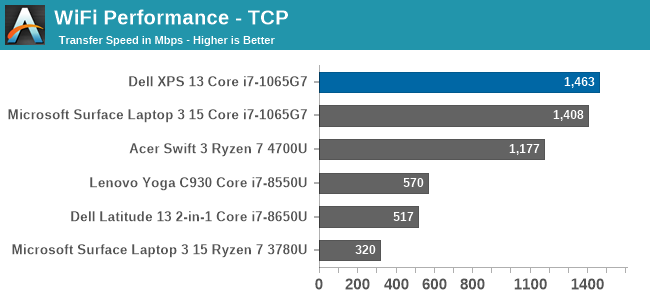
Performance is simply fantastic, and ever since Killer was able to base their network cards on Intel wireless, the stability concerns appear to be a forgotten memory. There was not a single time that the laptop had any issues with its network connection during any of the testing. That was certainly not the case on some of the older Qualcomm-based Killer products.
Audio
Dell offers Waves MaxxAudio Pro stereo speakers, at 2.5 Watts peak each, which are outfitted on the bottom of the laptops right on the edge of the device.
Sound quality is a bit on the tinny side, with not a lot of low end at all. The speaker setup does get quite loud though, with 83 dB(A) measured one inch over the trackpad at maximum volume. There was little to no distortion at peak volume either.
The dual-microphone array is found on the very top of the bezel, which would allow it to work with the device closed. It is a great way to hide the holes, with only the 2.25 mm 720p webcam showing in the bezel itself.
Thermals
Dell outfits the XPS 13 with dual fans and a single heatpipe to cool the 15-Watt Thermal Design Power of the Core processor under the hood. They have added hidden exhaust vents in the hinge, to allow more airflow without compromising the looks. There is also a layer of GORE thermal insulation under the keyboard, which helps keep that portion cool to the touch even under load.
To see how the XPS 13 performs under load, it was run at 100% for an extended period while monitoring the device.
This graph tells an interesting story, unlike most laptops we see. First, Dell has gone absolutely crazy with the PL2 level on the XPS 13, with a peak measurement of a whopping 42 Watts. But, that is not sustainable in a 13-inch laptop, and the CPU throttles in PL2 until it reaches the PL1 limit, which is right at 15 Watts in the XPS 13’s most performant mode. Most of the notebooks we have tested tend to allow a PL1 level above this, with maybe 20-21 Watts as a constant, but Dell clamps to 15 Watts, then spikes back up when the thermals allow, so we see this see-saw effect of the device running between 15 and 30 Watts. This is similar to how the XPS 13 2-in-1 behaved, and it would be nice to see the company address this with a more consistent power delivery under sustained load.
Over the duration of the test, the device averaged 18 Watts of draw, with an average CPU temperature of 80°C, with the four cores running at 2100 MHz. During this extended run, the noise level was very restrained, only hitting around 44 dB(A) measured about one inch over the trackpad. The GORE thermal insulation also did its job, with the keyboard deck remaining cool.
Software
Dell’s included software suite is a very polished set of applications, allowing the user to quickly get the device set up, adjusted, and of course, contact support. As with most manufacturers, they include a utility to get the latest updates, called Dell Update, and that includes some maintenance utilities as well.
Dell’s Power Manager software allows you to change the power profile, as well as adjust the battery charging. The Thermal Management tab allows you to pick a fan and CPU profile, or leave it as the default Optimzed setting which works well for most scenarios.
Dell offers a plethora of battery options to maintain and extend the life of the battery. Out of the box, it comes in an “Adaptive” setting which learns your usage patterns and tries to keep the battery at a good state of charge, but you can override that to keep the battery always at 100% charge in case you need it, or if you mostly use it on AC you can set it to keep the battery to a lower level of charge to prolong its life.
The days of laptops being saddles with an almost unending array of shareware and trial software seem to be mostly over, and even though Dell included Norton with the XPS 13, it can easily be removed if necessary.


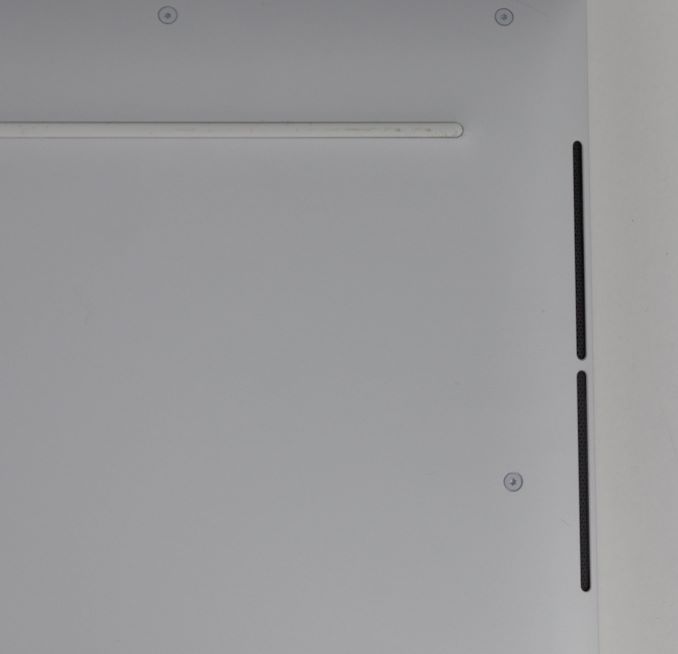
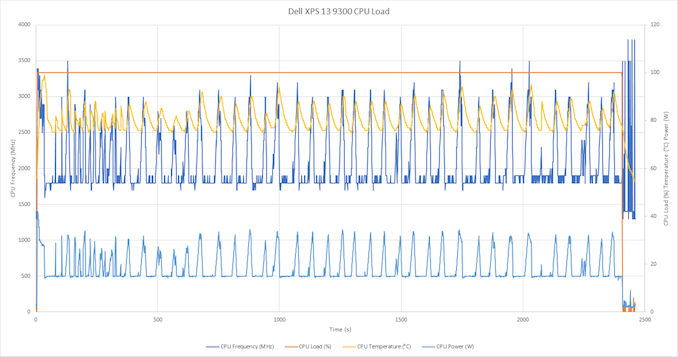
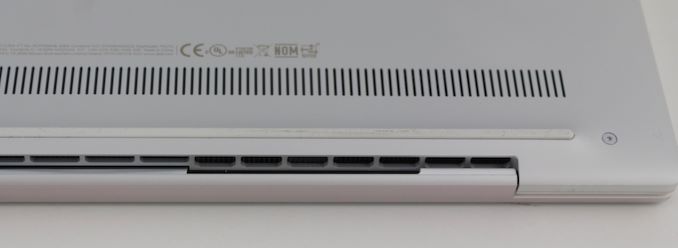

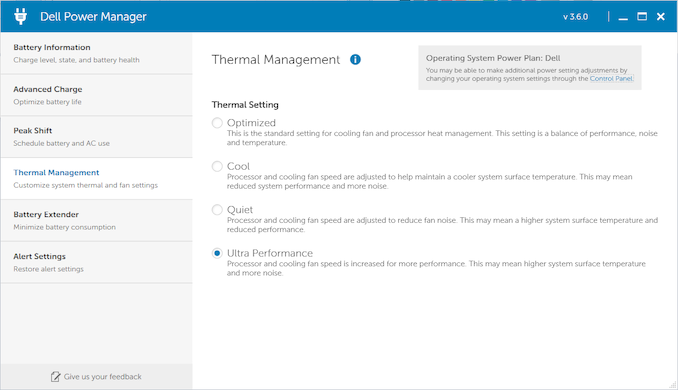
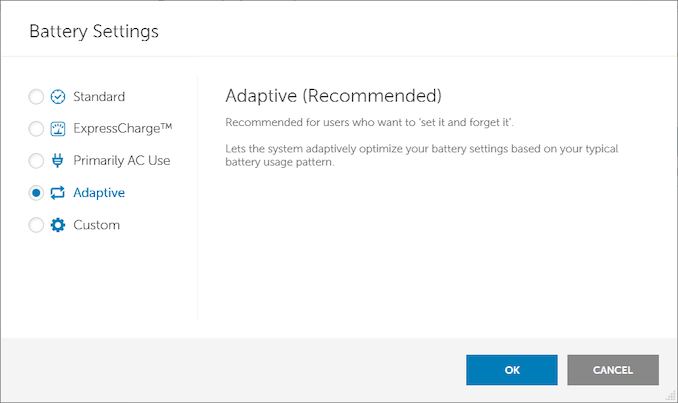








224 Comments
View All Comments
GreenReaper - Thursday, July 16, 2020 - link
So frustrating that Dell made yet another XPS hamstring by its thermal dissipation ability. The see-sawing ruins these systems for my brother, who happens to like to play a few games after work. It used to be possible to undervolt to fix this, but now I Tel has sent out firmware updates to disable that because it's protecting SGX enclaves from the Plundervolt vulnerability. I certainly won't be recommending this new version to him.flowingbass - Thursday, July 16, 2020 - link
I see dell is still under intel's payrollhaukionkannel - Thursday, July 16, 2020 - link
Ofcourse! It is the best way of making money. People buy Intel laptops. It does not matter if Intel cpus Are bad, people still buy them. Amd can make better cpus and people still don`t buy AMD laptops... so They Are making the only sensible thing... by usining intel cpus. They want to make money and sell laptops...sonny73n - Friday, July 17, 2020 - link
I’m buying an AMD laptop. Bite me.Spunjji - Friday, July 17, 2020 - link
I love it when people use the results of a tilted system to justify the continued existence of a tilted system. Circular arguments are so *neat*! 😐trivik12 - Thursday, July 16, 2020 - link
I hope we see a tigerlake version this year and an AMD version soon as well. Quality of display and build quality is great.Deicidium369 - Thursday, July 16, 2020 - link
Tiger Lake will be in the premium Dells - AMD won'tLenovo's new systems are Tiger Lake and there is an almost identical system with the top end Renoir - the Tiger Lake system wrecks the Renoir iGPU and with 4C vs 8C only 17% slower - those are benchmarks on Jul 3 2020.
Korguz - Friday, July 17, 2020 - link
still touting that cherry picked BS, huh ?mrvco - Thursday, July 16, 2020 - link
Other than gaming I'm primarily a Mac user, but the XPS 13 DE has been on my radar as a Linux machine. I'm still surprised that Apple hasn't been more aggressive with their updates to the 13" MacBook Pro to better compete with the XPS 13.Deicidium369 - Thursday, July 16, 2020 - link
XPS13 is the benchmark in that segment